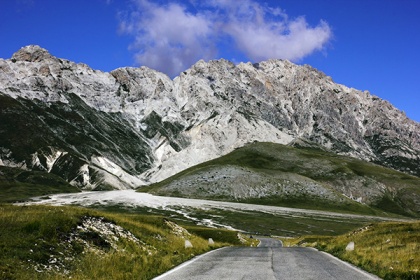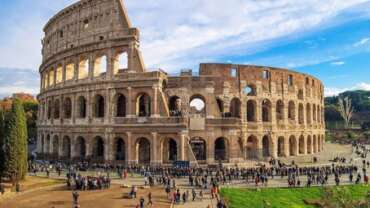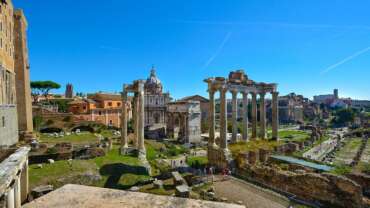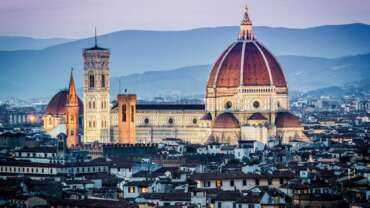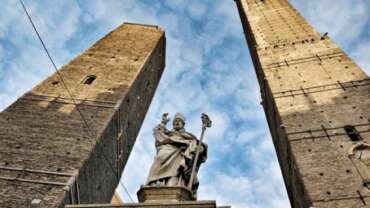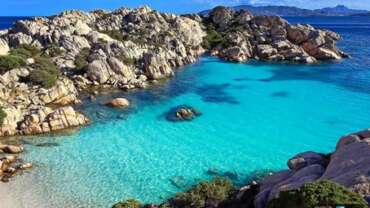South Italy
Abruzzo – is charming villages between lush nature and breathtaking landscapes
Territory of Abruzzo
The territory of Abruzzo is bordered to the north by the region of Marche, to the east by the Adriatic Sea, to the west by Lazio and to the south by Molise and is divided into two parts, one coastal, on the eastern side, which consists of the long Adriatic coast and the other, more inland, mainly mountainous that houses the three highest mountain massifs of the entire Apennine chain: the Gran Sasso d’Italia, which reaches the highest peak of the Apennines with its Corno Grande, the Majella, with Mount Amaro and the Sirente-Velino with Mount Velino, to which are added the Monti della Laga.
Useful information about Abruzzo
Abruzzo is a region between center and southern Italy. It has four provinces: L’Aquila, Chieti, Pescara, Teramo, as well as numerous villages, 23 of which are present in the prestigious club “The most beautiful villages in Italy”, putting the region in third place nationally. For its variety of landscapes and its beauty Abruzzo is fifth among the twelve best regions in the world for the quality of life according to the Huffington Post American. In addition, 75% of the animal and plant species present in Europe are kept on the soil of the region.
Art and culture of Abruzzo
Art and culture of Abruzzo have had a great importance from the classical age until more recent times: in Sulmona, in Abruzzo, was born Ovidio, the famous Latin poet, as well as Benedetto Croce, considered one of the major protagonists of Italian and European culture, and Gabriele D’Annunzio, great man of letters and prominent personality who has had so much influence on the culture of Abruzzo and of the whole of Italy. Abruzzo has also given birth to great painters among whom, in recent times, Filippo Palizzi, Teofilo Patini and Francesco Paolo Michetti stand out.
Food and flavours of Abruzzo
Abruzzo, like all Italian regions, has a great culinary tradition, mainly of mountainous inspiration, but also maritime, thanks to the recipes developed along the coast. The partial isolation of Abruzzo due to the morphology of its territory, has meant that this tradition has remained unchanged and quite independent from the rest of Italy. The cuisine of Abruzzo is rich in meat specialties and the most famous is represented by the arrosticini. Even in Abruzzo, of course, there are recipes for pasta among which stand out the spaghetti alla chitarra. There are various wines suitable to accompany these dishes but the most characteristic is the famous Montepulciano d’Abruzzo.
Places and tours of Abruzzo
There are many places and tours in Abruzzo, ranging from villages, with churches and museums, to natural attractions that have made the region deserve the title of “green region of Europe”. The things to see are many and all beautiful. There are several monuments worthy of note, such as the Rocca Calascio, or the Basilica of San Bernardino, and a myriad of wonderful national parks: the National Park of Abruzzo, Lazio and Molise, the Majella National Park and the National Park of Gran Sasso and Monti della Laga. But Abruzzo is also a region with a maritime vocation: during your stay you should visit one of the beautiful villages on the Adriatic coast, such as Francavilla al Mare, and immerse yourself in the beautiful sea of Abruzzo.
Basilicata – is pure air, among rocks, woods and natural masterpieces
Territory of Basilicata
The territory of Basilicata is mainly mountainous and hilly. It has the highest peaks in the Lucanian Apennines: the Pollino and Sirino massifs, Monte Alpi, Monte Raparo and the Maddalena mountain range. Basilicata also boasts the presence of an inactive volcano: Mount Vulture. The main plain of Basilicata is the plain of Metaponto. Basilicata overlooks the Ionian Sea and the Tyrrhenian Sea, where the Gulf of Policastro is located.
Useful information about Basilicata
Basilicata, also known as Lucania, is a region in southern Italy. It is divided into two provinces: the province of Potenza, which is also the capital, and the province of Matera. In addition to Potenza and Matera has other important centers in Policoro, Melfi and Pisticci. It is bordered to the north and east by Puglia, to the north and west by Campania, to the south by Calabria, south-west is washed by the Tyrrhenian Sea and south-east by the Ionian Sea.
Art and culture of Basilicata
Many, throughout Italy and beyond, have appreciated the art and culture of Basilicata. The influences of the magna grecia, the ancient Matera settlements and the impressive number of rock churches in the area are just some of the aspects that have made Basilicata the subject of study by artists and writers. The case of “Christ stopped at Eboli” by Carlo Levi is emblematic, as are the films on the Holy Scripture shot by Pier Paolo Pasolini in Basilicata.
Food and flavours of Basilicata
The food and flavours of Basilicata are varied and differ from village to village because they are isolated from each other by geographical factors and have each developed a cuisine based on the local crops and spontaneous growths. The recipes often use white meats and local spices, even spicy ones, and among the meat specialties there are the Gnummareddi, as well as the typical sausages such as sopressata, salame pezzente and Luganega, whose original name, Lucanica, comes from Lucania. There is no shortage, however, of seafood recipes: among the most famous is the baccala alla Lucana, prepared with peppers cruschi. The latter are dried sweet peppers and are another of the typical products of Basilicata.
Places and tours of Basilicata
Listing places and itineraries in Basilicata inevitably leads us to distinguish from the artificial beauties, of great historical and cultural value, and the natural beauties that this region can offer thanks to the variety of its landscapes. The Basilicata region offers evidence of any era from the ancient settlements of the park of Murgia materana, some of which date back to the Palaeolithic from which came to life the Sassi of Matera, famous throughout the world, which lasted until the Baroque period, which house an impressive number of houses and monuments and rock churches. Very important are also the testimonies of the Magna Graecia that we find, for example, in the archaeological park of Metaponto. From the point of view of naturalistic tourism we remember the Pollino National Park, one of the most beautiful natural parks in Italy, the lakes of Monticchio, the landscape of Val d’Agri and the maritime beauty of the Tyrrhenian coast.
Calabria – is wild nature, between intense flavors and beautiful waters
Territory of Calabria
The territory of Calabria represents the tip of the Italian boot. It is washed by the Ionian Sea to the east and by the Tyrrhenian Sea to the west and south west overlooking the Strait of Messina, a strip of sea that separates it from Sicily. It is mainly hilly and mountainous and has its highest peaks in Monte Serra Dolcedorme and Monte Pollino.
Useful information about Calabria
Calabria is a region of southern Italy with the capital Catanzaro. The other provinces of the region are Cosenza, Crotone, Vibo Valentia and the metropolitan city of Reggio Calabria. The region of Calabria is bordered by Basilicata and is washed by the Ionian Sea and the Tyrrhenian Sea.
Art and culture of Calabria
The historical importance, the dominations, the foreign influences are all factors that have influenced the Art and culture of Calabria. The bronzes of Riace, among the most important works related to Calabria, testify to the importance that this region had at the time of Ancient Greece, the territory in which he was born and lived Pythagoras. The cultural ferment of Calabria does not end, however, in that period and, indeed, arrive until recently with Umberto Boccioni, famous artist among the leading exponents of Futurism, passing through Tommaso Campanella, philosopher, theologian, poet and Dominican friar, among the most excellent minds of his time.
Food and flavours of Calabria
Food and flavors of Calabria originate in its peasant tradition: many typical recipes are linked to specific occasions, often religious. Particular importance in the Calabrian cuisine is given to all the foods to be preserved, such as cheeses, sausages and foods in oil and salt cured. Among these, the ‘Nduja stands out, a very spicy sausage with a soft texture typical of Calabria. The ‘Nduja is not the only hot product produced in Calabria: the Calabrian cuisine is, in general, very hot and has a strong presence of chilli pepper.
Places and tours of Calabria
The landscapes of the Calabrian territory are very varied: the city centers, from the provinces to the smaller ones like Lamezia Terme, the small villages like Gerace, Belmonte Calabro, Stilo (and many others should be mentioned), the places of nature, such as the National Park of Sila, and of course the beautiful beaches, those of the Tyrrhenian coast (San Nicola Arcella, to name one), and those of the Ionian coast (eg Roccella Jonica).
Campania – is a land of emotions, contrasts and millenary traditions
Territory of Campania
Campania is a region in southern Italy. It is the third largest region in terms of population (after Lombardy and immediately after Lazio), the most populous in southern Italy and the first in terms of density. Wedged between the Tyrrhenian Sea to the west and the southern Apennines to the east, the region borders Lazio to the northwest, Molise to the north and Puglia and Basilicata to the east. Campania is mainly hilly (50.8%), 34.6% of it is mountainous and 14.6% flat.
Useful information about Campania
In addition to the regional capital of Naples, the provincial capital cities are Avellino, Benevento, Caserta and Salerno. Along the coast of Campania there are four gulfs: the Gulf of Gaeta, the Gulf of Naples, the Gulf of Salerno and the Gulf of Policastro.
Art and culture of Campania
In the course of its history, Campania has repeatedly had roles of primary importance in the local and supraregional spheres. This has led to the development of an important combination of popular and artistic culture. Thanks to its historical, artistic, archaeological, architectural and religious contents and thanks to the immense and extraordinary artistic heritage present in Naples, Campania is one of the regions with the highest density of cultural resources in Italy.
Food and flavours of Campania
The cuisine of Campania is one of the most appreciated in the world, being able to export numerous products recognized at national and European level. Its cuisine, part of the Mediterranean diet, has been protected by UNESCO as an intangible heritage of humanity. The Neapolitan Pizza is the symbol of regional (and national) cuisine and is exported worldwide, in fact, since 2017 the art of Neapolitan pizzaiuolo has been declared by UNESCO as an intangible heritage of humanity. Other typical dishes of the Campania cuisine are: the cardone (typical dish of the province of Benevento), the pasta with beans typical of the province of Benevento, the caprese (Naples), the soup maritata (Benevento), octopus ‘alla luciana’ (Naples), spaghetti allo Scoglio (Naples), pasta with beans and mussels (Naples), paccheri al ragù (Naples), chocolate aubergines (Salerno), maccaronara (Castelvetere sul Calore – Avellino), crusìcchi (Salerno), mugnatiello (Benevento). The confectionery tradition is also very vast, just think of Baba, Chiacchiere, Delizia al limone, Struffoli, Sfogliatella, Pastiera and Biscotti di Castellammare.
Places and tours of Campania
Campania offers breathtaking landscapes and scenery, from the mountains to the coast, passing through lakes and volcanoes. The region has 4 volcanoes, including the most famous and still active, Vesuvius. The most famous islands of Ischia, Capri and Procida are attractive for tourists from all over the world, such as the Sorrento coast and the Amalfi coast. The region includes four areas that are historically, culturally and morphologically different from each other. Starting from the north, the sub-regions are: Terra di Lavoro, Sannio, Irpinia, and Cilento. Avellino, Benevento, Caserta and Salerno are just some of the other destinations to visit in this magnificent region.
Molise – is a small ancient world between uncontaminated nature and magnificent landscapes
Territory of Molise
Molise is the second smallest region in Italy. The territory of Molise is divided almost equally between mountains (about 55% of the territory) and hills (the remaining 45% of the territory) and the mountainous area extends between the Apennines of Abruzzo and the Samnite Apennines. The Meta and Matese mountains mark, respectively, the borders with Abruzzo and Lazio and with Campania. The flat areas are very few and very small.
Useful information about Molise
Molise is a region of Southern Italy with the capital Campobasso, which is also one of the two provinces. The other province of the region Molise is Isernia and, in addition to the provinces, there are 136 municipalities. Molise borders Abruzzo to the north, Lazio to the west, Campania to the south-west, Puglia to the south-east and is washed by the Adriatic Sea to the east.
Art and culture of Molise
The region of Molise is located in the area formerly identified as the Sannio area because it was inhabited by the Samnites, whose traces are evident in the art and architecture of the whole Molise. The region, later, had a strong development both in Romanesque and Medieval times, when the latter suffered greatly from the Swabian style. The region also has many architectures related to the styles of Neoclassical and Eclecticism thanks to the work of reconstruction occurred around 1800 after a major earthquake.
Food and flavours of Molise
Molise cuisine is very varied, and can boast as many as 159 traditional food products. Food and flavours of Molise have ancient roots, such as the famous Venafro oil, called Aurina for its characteristic colour, which can be found in the writings of Horace, Pliny and other Roman poets, proving that it was already very well known many years ago. Molise also boasts a remarkable production of pasta and the most typical cut of the region is that of cavatelli, seasoned with various sauces, even if the most famous combination is that with pork sauce.
Places and tours of Molise
Speaking of the places and itineraries of Molise, one can certainly start from Isernia, the ancient capital of the Samnite populations. The province of Isernia also has much to see: the Collemeluccio reserve, a protected natural area and the medieval village of Venafro. From the point of view of the natural tourism of the mountain landscapes, you are spoilt for choice: think of the attractions of the Apennine ridge and the matese massif (in particular Campitello Matese, which hosts a famous ski resort often the venue for events related to winter sports).
Apulia – is olive trees between white stone and pristine lands
Territory of Apulia
The territory of Puglia borders on Molise, Campania and Basilicata and is the easternmost region of Italy. One of the regions with the greatest coastal development with an extension of the coasts of about 865 km washed to the south by the Ionian Sea and to the north and east by the Adriatic Sea. Apulia is the least mountainous region in Italy, in fact it consists mainly (98%) of flat land, consisting of the Tavoliere delle Puglie, which is the largest plain in Italy after the Po Valley and occupies almost half of the Capitanata, and hills divided between the Murge and Serre Salentine.
Useful information about Apulia
Apulia is a region of southern Italy, with the capital Bari, has always been a focal point in trade and political-cultural contacts with the Middle East. The other cities of Puglia are Lecce, Brindisi, Foggia, Taranto, Barletta, Andria and Trani, all fascinating destinations full of beaches and UNESCO sites.
Art and culture of Apulia
Apulia has been the cradle of ancient civilizations that have left works of art such as prehistoric graffiti in the caves of Porto Badisco. The region of Puglia has always been affected by its position between East and West: in fact, because of its location, it was considered a real bridge between two worlds, thus affecting the Western Roman-Germanic culture and the Eastern Greek-Byzantine. For this reason, the artistic cities of Apulia are characterized by the overlapping of several artistic styles, with examples dating back to the presence of the Greeks.
Food and flavours of Apulia
The flavors of Puglia are many and all wonderful so you will never tire of knowing and appreciate them. The centuries-old culinary tradition of Puglia is rich in recipes and tasty dishes that can strike you to the point of wanting to know them in depth, to study the origins and preparation. There are many recipes that this cuisine of Apulia presents, which highlights the raw materials used, both land and sea. The most typical dish of Apulian cuisine is that of “Orecchiette with horse meat sauce”, but are no less known the “Orecchiette with turnip tops”, the “chicory with broad bean puree”, and those that reconnect the territory to the Mediterranean, such as “Cavatelli with mussels” or Bari baked rice also called rice with potatoes and mussels. The various traditional dishes are interpreted differently from province to province and from city to city.
Places and tours of Apulia
Apulia is marked by ancient populations and various dominations that have left important archaeological finds, castles, ancient villages and palaces throughout the region. The smaller towns and villages are home to sumptuous historic buildings, mostly based on the Romanesque and Baroque, of which the one from Lecce represented by countless palaces and churches, is the richest and most original. Basilicas, cathedrals and sanctuaries, different artistic expressions united by the faith; and again, patronal festivals, village festivals and evocative historical re-enactments renew each year ancient habits linked to the time of the festival. Among the most excellent Romanesque buildings and the oldest in Puglia, is the Basilica of St. Nicholas of Bari. This superb masterpiece of architecture, as austere as a fortress, overlooks its tripartite facade flanked by bell towers.



